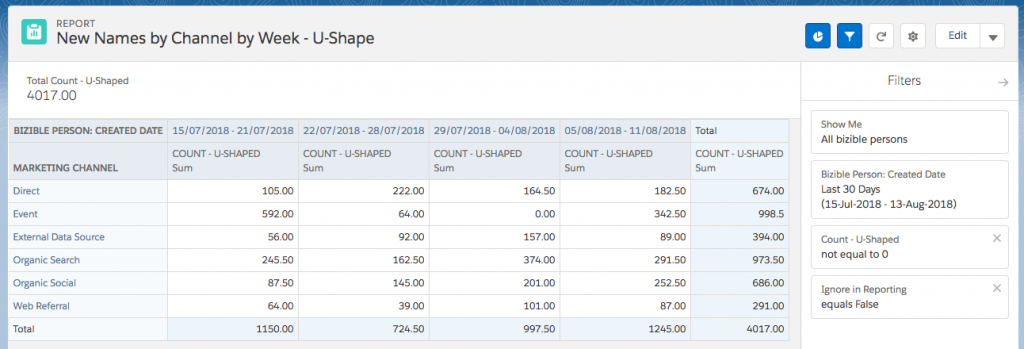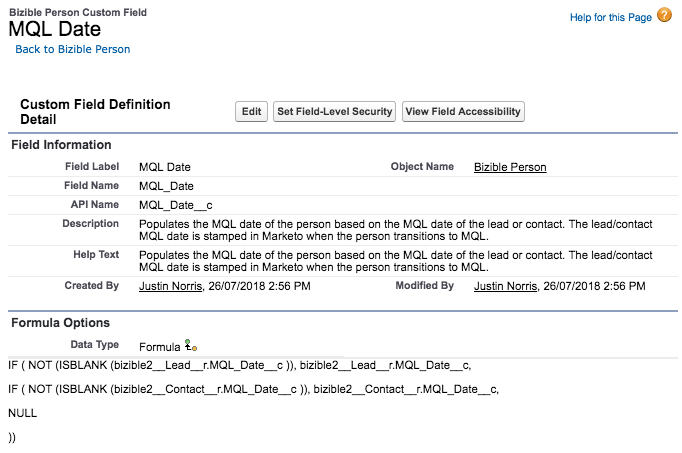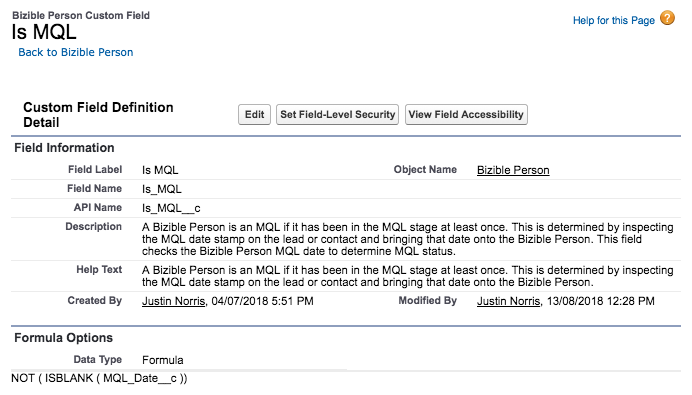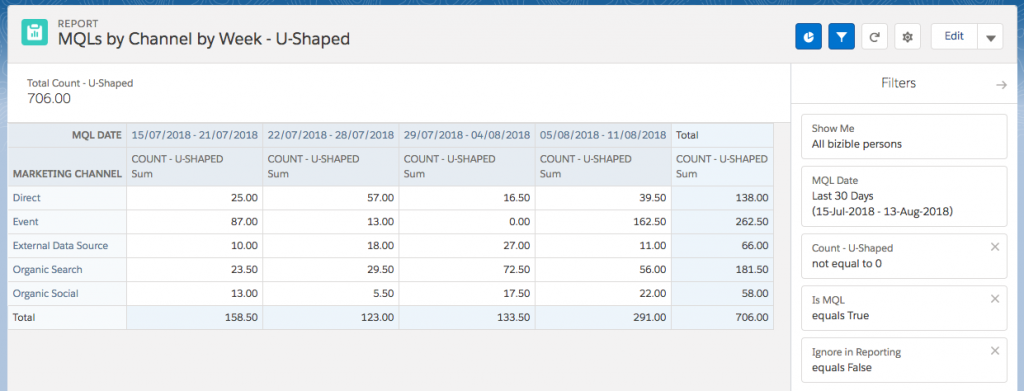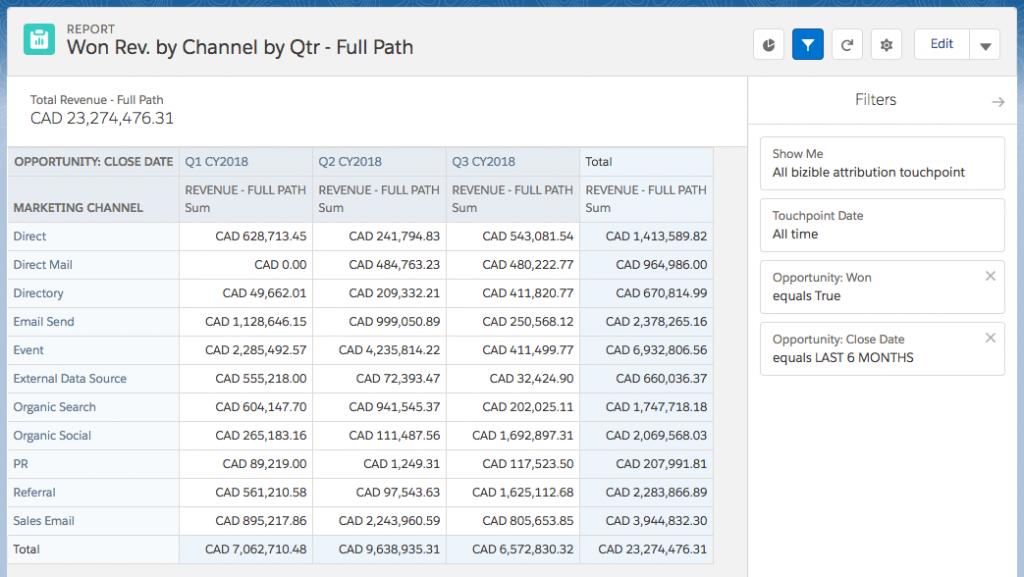We recently came across a staggering statistic: 58% of marketers rate their ability to measure and analyze marketing performance as “needs improvement or worse.” (2018 Marketing Measurement & Attribution Survey Report).
In other words, 6 out of 10 marketers struggle with measuring the effectiveness of their marketing efforts and demonstrating the impact marketing has on their organization. Even marketers who have advanced attribution technology at their disposal can struggle to get the business value they’re seeking. So where are marketers stumbling?
In this post, we’ll address one of the biggest challenges: how to start leveraging your data to gain actionable insights and produce meaningful reports.
Marketing Measurement Preliminaries
Reporting projects work best when they follow a structured process:
Establish Goals: The first question to ask is why do we measure? Lori Wizdo of Forrester Research summed it up nicely in a Marketo webinar: according to her, we measure to prove or validate a decision or the value of marketing or to get better (process improvement). We would add that the insights from good measurement also provide input and guidance into the marketing planning process.
So before you begin, it’s essential to be crystal clear on your goals, the questions you’re trying to answer, or the problems you’re attempting to solve. What story do you want to tell? What decisions will be made as a result? Too often thse fundamentals are poorly thought out, leading to frustration for all involved.
Report Design: Next, you need to design the report and determine the specific dimensions, metrics, and dataset it will contain. A common experience is to provide a business user with exactly what they ask for, only for them to still feel that their needs are unmet. This is because the insight a business user is actually looking for is not always contained in the report they request. A good analyst (or a MOPS person with an analyst hat on) will ask clarifying questions, establish common definitions (“so, what do you really mean by lead?”), and even sketch out a visual of the final report to make sure there’s alignment. Only then do you build the report, knowing you have a solid set of requirements.
Report Build: Once you go to build, it’s not uncommon to run into roadblocks or dead-ends. For example, you might discover that you lack an essential data point or that your objects don’t link in the way that you need. To solve these problems, I also think it’s critical to understand what’s happening “under the hood” in your reporting “machine.” This fluency will allow you to quickly size up a reporting request and evaluate whether it’s achievable (and more easily devise creative solutions when it’s not).
With all this in mind, let’s lift up the hood on the Bizible object model, so we can better understand how to produce the insights we need. Then we’ll walk through how to build some reports addressing common business questions using Bizible data. (In this case, we’ll use Salesforce as an example CRM.)
Touchpoints, Attribution Touchpoints, and Person—What’s the Difference?
When first getting started with Bizible, it’s easy to get Bizible Touchpoints and Bizible Attribution Touchpoints confused.
Bizible Touchpoints (BT) are used for understanding all marketing interactions related to people, as they contain the complete touchpoint history for each person. As a reminder, these touchpoints are created in CRM for the anonymous first touch, the lead creation touch, and any subsequent form submission or touchpoint that you choose to sync from an offline campaign.
Bizible Touchpoints are used to answer questions related to people, such as lead generation metrics. For example, how many new names did I get this week/month/quarter? Which channels are delivering the most new names? Which channels are more or less costly to create a new name? Attribution models providing the best insight into people-based metrics are First Touch (FT), Lead Creation (LC), and U-Shaped, as these models place heavy emphasis on early-stage interactions and top of funnel engagement. I prefer U-Shaped as it factors in both the FT and LC touchpoint, both of which are important.
Bizible Attribution Touchpoints (BATs) represent the relevant touchpoints of all the people connected to the opportunity (either via Opportunity Contact Roles or via a shared Account ID, depending on your settings). Unlike BTs (which are mainly connected to people) BATs can be associated with revenue. As such, you’ll use BATs to answer questions related to opportunities, including how many opportunities opened or closed, the pipeline value and revenue won.
Touchpoints are duplicated between BT and BAT objects, so you’ll want to use one or the other depending on what questions you’re trying to answer.
There’s a third object that can be very important for reporting on people metrics: the Bizible Person (BP). The BP solves the age-old problem of how to represent both lead and contact information in the same report. It unites all BTs related to a person, whether they exist as a lead or a contact. The BP acts as a bridge object, to help reports span across lead and contact, and, is very useful in producing more sophisticated reports on people.
With this clarity on Bizible’s terms and functionality, we now have a better foundation to create reports and understand the data behind them.
Recommended Reports and How to Build Them
Equally essential in asking the right question is selecting the appropriate attribution model to yield the best answer. One of the many benefits of Bizible is all models run concurrently, so you can easily switch to align the proper model with your business question to produce a more insightful result. In the examples below, we highlight which model is optimal.
Lead Generation
Whether for campaign planning, budgeting purposes or otherwise, understanding how many new names your efforts have produced and where are they coming from is a key marketing metric. The steps to obtain your answer:
Questions Answered: Which marketing channels are best at generating new names?
Under the Hood: This report tallies new names entering the database, summarized by channel and cohorted by the Bizible Person (BP) created date.
Optimal Models: U-Shaped, for balance between FT and LC stages
Report Title: New Names by Channel by [Period] – U-Shaped
Report Type: Salesforce, Bizible Person with Bizible Touchpoints
Report Description: Show all Bizible Persons and summarize touchpoints by marketing channel. Sum the “Count – U-Shaped” field. Filter Time Frame using Bizible Person: Created Date.
Bizibe Persons grouped by Channel showing U-Shaped attribution credit by week in Salesforce Lightning.
Marketing Qualified Leads
Here we take a look at one of the more popular metrics, tracking MQLs. This report identifies the acquisition sources generating names that are likely to become an MQL. To do so, we’ll need to identify the PERSON that has become an MQL and evaluate the channels creating those names. Essentially, this report is a subset of the previous report, looking only at those people that became an MQL.
Bizible doesn’t track MQLs out of the box, so to accomplish this, we’ll also need to add an MQL date stamp to both the lead and contact objects and a few custom formula fields on the Bizible Person record, which will inspect if the associated lead or contact has that date populated. One of the formula fields will copy the MQL date onto the Bizible Person:
Another formula field provides a simple boolean that makes it easy to tell whether a person has become an MQL or not, which is convenient to use in reporting:
Questions Answered: Which marketing channels are best at generating people that become new MQLs?
Under the Hood: This report shows marketing contribution for new names entering the database that have reached MQL, summarized by channel and cohorted by the BP MQL date.
Optimal Models: U-Shaped
Report Title: MQLs by Channel by [Period] – U-Shaped
Report Type: Salesforce, Bizible Person with Bizible Touchpoints
Report Description: Show all Bizible Persons with a filter of Bizible Person: Is MQL = TRUE and summarize touchpoints by marketing channel. Sum the “Count – U-Shaped” field. Filter Time Frame using Bizible Person MQL Date.
Bizibe Persons that are MQLs grouped by Channel showing U-Shaped attribution credit by week in Salesforce Lightning.
Opportunity Pipeline
Moving beyond the acquisition metrics, you want to dive a little deeper for insight into opportunity creation by channel, on an FT/LC/OC basis. To accomplish this:
Questions Answered: Which channels are influencing the creation of opportunities?
Under the Hood: This report shows marketing contribution for the number of opportunities created and summarized by marketing channel, cohorted by the opportunity created date.
Optimal Models: W-Shaped
Report Title: Number of Opportunities by Channel by [Period] – W-Shaped
Report Type: Salesforce, Bizible Attribution Touchpoint with Opportunities
Report Description: Show all Bizible Touchpoints and summarize by marketing channel. Sum the Count – W-Shaped field. Filter Time Frame using the Opportunity Create Date.
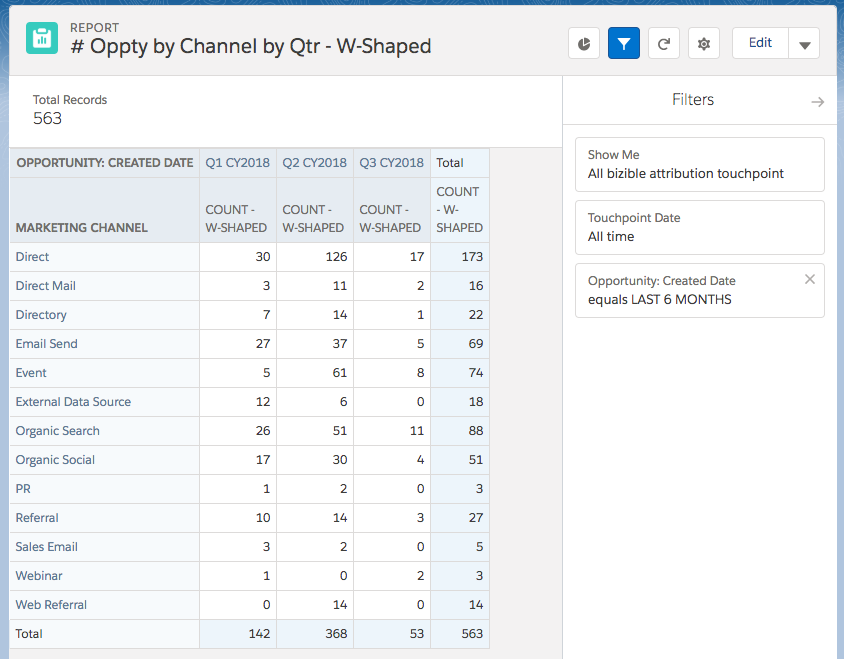
Attribution Touchpoints grouped by marketing channel showing W-Shaped attribution credit by quarter. Note: this is dummy data, in a real report you’d see a lot more fractional numbers as the opportunity credit is sliced according to the logic of the fractional attribution model.
Revenue Won
Understanding contribution to revenue is one of the most critical metrics for both the organization and quite honestly, for you as a marketer and your career. Future campaigns, allocation of resources, contribution to your organization’s goals—knowing which channels are influencing revenue is essential. To create:
Questions Answered: Which marketing channels are influencing the most revenue?
Under the Hood: This report shows the marketing contribution for closed/won revenue, summarized by marketing channel and cohorted by the opportunity close date.
Optimal Models: Full Path
Report Selection: Won Revenue by Channel by [Period] – Full Path
Report Type: Salesforce, Bizible Attribution Touchpoint with Opportunities
Report Description: Show all Bizible Touchpoints with a filter of Opportunity Won = TRUE and summarize touchpoints by marketing channel. Sum the Revenue – Full Path field. Filter Time Frame using the Opportunity Close Date.
Attribution Touchpoints grouped by marketing channel where opportunity is won, showing Full Path attribution credit by quarter.
The Value of Metrics
Attribution tools alone don’t make a marketer smarter. Instead, we advance by asking the right questions, applying the appropriate model and knowing which reports produce the corresponding answer. Once you understand how your tool works under the hood, you’ll gain confidence your report is answering the right questions and build a foundation for extending the native capabilities to meet your company’s requirements.
Does your organization need help achieving ROI from Marketo? Learn how the Marketo experts at MERGE can help. Contact us today!
